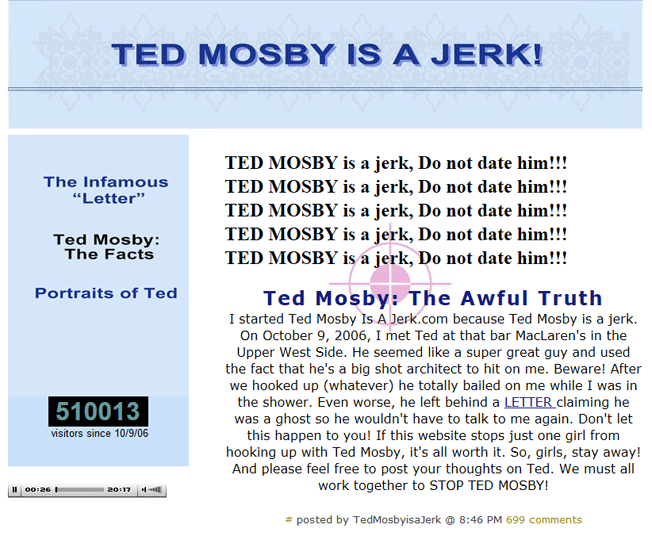MARKETING
The Definitive Guide to Online Reputation Management

There are a lot of misconceptions about online reputation management. Some people think it’s just social media monitoring, while others believe it has something to do with public relations, and still others have no idea the impact it can have on sales.
In this guide, I’ll explain the role of online reputation management in today’s digital age, explain why it matters, and outline 10 tips for improving and protecting your brand’s online image.
Why Does Reputation Management Matter?
Just a few years ago, the internet was very different. Companies didn’t engage customers, they just sold (or tried to sell) to a passive audience People could not express their voice in a powerful way, and the overall communication landscape was very “top down.”
The situation has radically changed. Today, websites are no longer static brochures. User-generated content is a must. And regular interactions on social networks are vital to any business success.
No matter the size of your business, people are talking about you, including prospects, customers, clients, and their friends. They are tweeting about your latest product, leaving a comment on your blog, posting a Facebook update about their customer experience, and much more.
If you think you can skimp on reputation management, or if you think you can make it without taking into account people’s voices, opinions, and reviews, think again.
Today’s Brands Need to Be Transparent
One of the most important business commandments is “Be transparent.” Opening up to criticism and feedback seems beneficial for companies that embrace this new communication mode with their audience.
What does being “transparent” mean? Here are some examples:
- allowing employees to talk about products and services publicly
- establishing a 1-to-1 communication channel
- asking for feedback
- not hiding criticism, and addressing it publicly
Easier said than done! Most small and medium sized companies do not invest much on communication, and they struggle with this concept. As a result, their efforts usually are incorrect or inconsistent.
Being transparent is risky. But in the long run, not being transparent is riskier.
Online Reputation Management “Failures”
Being open does not come without a price. If you and your brand accept feedback, customer opinions, and so on, you also must be ready to face them promptly.
Consider these scenarios:
- What if your product/service sparks too much criticism?
- What if your employees are not social media savvy?
- What if your competitors take advantage of this?
These are just a few reasons you need to have a proper online reputation management plan in action before embarking on a transparency journey.
Here are three famous cases of reputation management failure in the digital era:
- Dark Horse Café received a tweet criticizing their lack of electrical outlets for laptops. Their response was something like: “We are in the coffee business, not the office business. We have plenty of outlets to do what we need.” Needless to say, defensive/aggressive behavior doesn’t work in the online world. Many blogs reported the fact as a negative public relations case.
- Nestlé received negative comments about their environmental practices a few years ago, and they did not address them. People started becoming aggressive and posted altered versions of the Nestlé logo, forcing the company to close its public page. Takeaway? Do not pretend people are not talking, and address criticism as soon as possible.
- Amy’s Baking Company fought fire with fire against a one-star internet review. Their insults against the reviewer eventually were picked up by the local news. Negative attention is not good publicity.
The lesson here? Pay attention to your online reputation and respond–kindly–to poor reviews. Don’t let your ego get in the way of being professional. Remember, you aren’t just responding to the person who left a review, you are showing everyone else online who your brand is.
The Key to Online Reputation Management: Listen To What People Are Saying About Your Brand
What are people saying about you? Good online reputation management is not just reacting well to what people say about you, your brand, or your products and services, but also about whether to react at all and, if so, when.
Sometimes a reaction is not necessary, and sometimes a reaction that is too late can cost you millions.
A proactive approach to the matter consists of monitoring your public reputation regularly, and not just when you come to know about a specific event to deal with.
How do you do this? By using social media monitoring tools that keep an ear on what people are saying about your brand.
Social media monitoring allows companies to gather public online content (from blog posts to tweets, from online reviews to Facebook updates), process it, and see whether something negative or positive is being said affecting their reputation.
Social media monitoring can be both DIY (Google Alert is an example of a free web monitoring tool accessible to anyone) and professional, depending on the size of the business involved.
Watch for Online Reputation Bombs
In the online reputation management scenario, companies should be aware of two types of harmful content. One is represented by complaints on social networks. They need to be addressed properly, but unless your company has serious problems, they do not pose a real challenge to your business.
The other is what I define as “online reputation bombs,” which affect your reputation and sales long term and can severely damage a business. They are very powerful because, unlike social network content, they are prominent in search engine results.
What if someone Googles your brand name and finds defamatory content? Let’s see what they are:
- Negative Reviews: Review sites allow users to express their opinion on your brand. Did they like your service/product? Would they recommend it? Negative content can affect your sales, and addressing the criticism on the site may not be enough. Websites like Ripoff Report and Pissed Consumer provide the perfect platform for this kind of negative content.
- Hate Sites: Some people go beyond simple negative reviews and create ad hoc websites with their opinions, some of them containing illegal content. So-called “hate sites” sometimes address companies and public figures with insults and false information. Needless to say, a search result like “The truth about NAMEOFYOURCOMPANY” or “NAME scam/rip off” will make your potential customers run away!
- Negative Media Coverage: Phineas T. Barnum used to say “There’s no such thing as bad publicity.” That may be true for controversial public figures, but unfavorable TV, print, and online media coverage negatively impact companies and brands.
What do you do if your business is the victim of a smear campaign?
What To Do if Your Company is Subjected to an Online Reputation Smear Campaign
The first thing most companies wonder is “Can we call the cops?” I get it; being unfairly targeted feels illegal. But in most cases, online comments are not a legal matter.
Article 19 of The Universal Declaration of Human Rights states that:
“Everyone has the right to freedom of opinion and expression; this right includes freedom to hold opinions without interference and to seek, receive and impart information and ideas through any media and regardless of frontiers.”
Everyone has the right to express their voice about your brand. There are, however, certain boundaries that need to be respected. Some of the negative content online actually is illegal. Why?
- It uses defamatory language
- It reports false information
- It is aimed at damaging the company’s reputation
How do you react to all of this? How do you defend yourself or your company from this kind of illegal behavior?
Depending on the scope of the problem, several paths can be pursued in order to restore your online reputation:
- Aggressive SEO: Ranking on pages one or two of Google for your industry and brand name is one of the best ways to push down bad publicity. The first thing that you or your online reputation management company should do is devise a search marketing strategy that increases the ranking of positive content, owned by either you or third parties. The search engine game is too important to be ignored, and it is the first step in restoring your image.
- Review Removal: Did a user claim something false about your company? Is that review clearly aimed at destroying your reputation rather than providing feedback? Does it contain improper language? Legal liaison and speed of reaction will make it possible to remove the negative review.
- Online Investigations: In case of serious attacks on your brand image, it may be necessary to hire skilled online analysts to investigate untraceable threats and attackers via email tracing, data cross-indexing, and other information collection techniques. Cyber investigations are the definitive path to get to the bottom of the most difficult reputation management cases.
These strategies are only required in the most extreme cases. Most businesses can manage their online reputation by following these 10 tips.
10 Online Reputation Management Tips
Calling it “online reputation” really is redundant. Your online reputation is your reputation. In the digital era, nothing protects your brand from criticism. This is good from a freedom of speech perspective; bad if your company has been defamed and attacked.
To help you stay on top of your reputation, here are ten practical tips that sum up what we have covered in this guide. The world of brand reputation will change in the coming years, but following these simple tips will help you keep your name.
1. Become Well Respected
Trust is a perishable asset and it is hard to gain. Working to build respect work is more important than any other online reputation management commandment.
2. Be Radically Transparent
After years of hiding critics, McDonald’s publicly forced egg suppliers to raise hens’ living standards according to the People for the Ethical Treatment of Animals request.
Being transparent about shows you care about your customers and are willing to make changes when things go wrong.
3. Monitor What People Say About Your Brand
In addition to all the reasons to monitor your online reputation, social media monitoring also can increase sales. These days, lots of people ask questions via Twitter and Facebook because they evaluate whether or not they should buy from you. Showing you are responsive makes your brand look reliable.
4. React Quickly and Politely
In case of a customer complaint via Twitter, for example, a prompt and simple “Thanks for making us aware of the problem. We are working on it and will get back to you as soon as possible.” is better than a late reply with more information.
5. Address Criticism
In 2009, Whole Foods CEO John Mackey wrote an op-ed on Obama healthcare reform, which caused a controversy among WF customers. Two days later, the company published a written statement recognizing there were “many opinions on this issue, including inside our own company” and invited people to share their opinion about the article and health care changes. They didn’t just ignore it and hope it would go away; they addressed the issue head-on.
Responding to negative feedback shows you care and are working hard to fix any issues.
6. Pay Attention to Your Google Results
First impressions count, and we do judge many books by their cover. If the words “scam” and “rip off” are associated with your brand, then that is something you should worry about.
A strong SEO strategy is your best defense against negative press, reviews, and false reports.
7. Learn From Your Detractors
Criticism can be the chance to learn more about your audience and craft a better message in the future. Motrin’s controversial “baby-wearing moms” commercial sparked a lot of criticism. It did not come from competitors or illegitimate attackers, but from people in Motrin’s target audience who felt offended by their promotional content.
If the online responses to your brand are legitimate, it might be time to reconsider your marketing strategy or responses.
8. Attack Your Illegitimate Attackers
Sometimes we simply have to fight illegal behavior. In 2009, Domino’s Pizza employees who posted disgusting videos of themselves playing with food were fired and arrested. Another example is people who post false information on the internet. Sometimes, if you don’t sue them, they might do it again.
9. Learn From Your Mistakes
CORRECTION: @jmbergoglio is not the account of Jorge Mario Bergoglio. Our apologies.
— Boston.com News (@BostonDotCom) March 13, 2013
Sony certainly learned a reputation management lesson back in 2005. The company placed copy protection (XCD) on its CDs which created computer vulnerabilities that malware could exploit. Instead of being upfront about their mistake, Sony stonewalled criticism and lost millions in class-action lawsuits.
If you’ve made a misstep, own up to it and take action to fix the issue.
10. Ask For Help If Necessary
If your online reputation management efforts are not enough to protect or restore your brand image, you have the choice to request help from a professional. Working with an online marketing company or reputation management firm may be your only resort.
Time needed: 5 minutes.
Here are 10 tips to protect your online reputation management
- Become Well Respected
Building and maintaining trust in your business can protect you from online smear campaigns.
- Be Radically Transparent
Share the good — and the bad– about your company to build trust.
- Monitor What People Say About Your Brand
You can’t protect your reputation if you don’t know what people are saying.
- React Quickly and Politely
A prompt “Thanks for making us aware of the problem. We are working on it and will get back to you as soon as possible.” is better than a late reply with more information.
- Address Criticism
Don’t ignore criticism, responding quickly shows you care about your customers.
- Pay Attention to Your Google Results
If the words “scam” or “ripoff” are associated with your brand, it is time to take action. A strong SEO strategy can protect your brand by pushing down negative feedback.
- Learn From Your Detractors
Criticism can be the chance to learn more about your audience and craft a better message in the future.
- . Attack Your Illegitimate Attacker
Sometimes, if you don’t sue or push back against detractors, they might do it again.
- Learn From Your Mistakes
If you’ve made a misstep, own up to it and take action to fix the issue.
- Ask For Help If Necessary
If your online reputation management efforts are not enough to protect or restore your brand image, you have the choice to request help from a professional.
Conclusion
Managing your online reputation starts with listening to what your customers have to say and finding ways to connect with them. Replying to online criticism is crucial and building an SEO strategy is crucial, but it might not be enough to protect your brand from smear campaigns. In those cases, it might be time to get professional help.
What do you do to protect your online reputation?
See How My Agency Can Drive Massive Amounts of Traffic to Your Website
- SEO – unlock massive amounts of SEO traffic. See real results.
- Content Marketing – our team creates epic content that will get shared, get links, and attract traffic.
- Paid Media – effective paid strategies with clear ROI.
MARKETING
Ecommerce evolution: Blurring the lines between B2B and B2C

Understanding convergence
B2B and B2C ecommerce are two distinct models of online selling. B2B ecommerce is between businesses, such as wholesalers, distributors, and manufacturers. B2C ecommerce refers to transactions between businesses like retailers and consumer brands, directly to individual shoppers.
However, in recent years, the boundaries between these two models have started to fade. This is known as the convergence between B2B and B2C ecommerce and how they are becoming more similar and integrated.
Source: White Paper: The evolution of the B2B Consumer Buyer (ClientPoint, Jan 2024)
What’s driving this change?
Ever increasing customer expectations
Customers today expect the same level of convenience, speed, and personalization in their B2B transactions as they do in their B2C interactions. B2B buyers are increasingly influenced by their B2C experiences. They want research, compare, and purchase products online, seamlessly transitioning between devices and channels. They also prefer to research and purchase online, using multiple devices and channels.
Forrester, 68% of buyers prefer to research on their own, online . Customers today expect the same level of convenience, speed, and personalization in their B2B transactions as they do in their B2C interactions. B2B buyers are increasingly influenced by their B2C experiences. They want research, compare, and purchase products online, seamlessly transitioning between devices and channels. They also prefer to research and purchase online, using multiple devices and channels
Technology and omnichannel strategies
Technology enables B2B and B2C ecommerce platforms to offer more features and functionalities, such as mobile optimization, chatbots, AI, and augmented reality. Omnichannel strategies allow B2B and B2C ecommerce businesses to provide a seamless and consistent customer experience across different touchpoints, such as websites, social media, email, and physical stores.
However, with every great leap forward comes its own set of challenges. The convergence of B2B and B2C markets means increased competition. Businesses now not only have to compete with their traditional rivals, but also with new entrants and disruptors from different sectors. For example, Amazon Business, a B2B ecommerce platform, has become a major threat to many B2B ecommerce businesses, as it offers a wide range of products, low prices, and fast delivery
“Amazon Business has proven that B2B ecommerce can leverage popular B2C-like functionality” argues Joe Albrecht, CEO / Managing Partner, Xngage. . With features like Subscribe-and-Save (auto-replenishment), one-click buying, and curated assortments by job role or work location, they make it easy for B2B buyers to go to their website and never leave. Plus, with exceptional customer service and promotional incentives like Amazon Business Prime Days, they have created a reinforcing loyalty loop.
And yet, according to Barron’s, Amazon Business is only expected to capture 1.5% of the $5.7 Trillion addressable business market by 2025. If other B2B companies can truly become digital-first organizations, they can compete and win in this fragmented space, too.”
If other B2B companies can truly become digital-first organizations, they can also compete and win in this fragmented space
Joe AlbrechtCEO/Managing Partner, XNGAGE
Increasing complexity
Another challenge is the increased complexity and cost of managing a converging ecommerce business. Businesses have to deal with different customer segments, requirements, and expectations, which may require different strategies, processes, and systems. For instance, B2B ecommerce businesses may have to handle more complex transactions, such as bulk orders, contract negotiations, and invoicing, while B2C ecommerce businesses may have to handle more customer service, returns, and loyalty programs. Moreover, B2B and B2C ecommerce businesses must invest in technology and infrastructure to support their convergence efforts, which may increase their operational and maintenance costs.
How to win
Here are a few ways companies can get ahead of the game:
Adopt B2C-like features in B2B platforms
User-friendly design, easy navigation, product reviews, personalization, recommendations, and ratings can help B2B ecommerce businesses to attract and retain more customers, as well as to increase their conversion and retention rates.
According to McKinsey, ecommerce businesses that offer B2C-like features like personalization can increase their revenues by 15% and reduce their costs by 20%. You can do this through personalization of your website with tools like Product Recommendations that help suggest related products to increase sales.
Focus on personalization and customer experience
B2B and B2C ecommerce businesses need to understand their customers’ needs, preferences, and behaviors, and tailor their offerings and interactions accordingly. Personalization and customer experience can help B2B and B2C ecommerce businesses to increase customer satisfaction, loyalty, and advocacy, as well as to improve their brand reputation and competitive advantage. According to a Salesforce report, 88% of customers say that the experience a company provides is as important as its products or services.
Market based on customer insights
Data and analytics can help B2B and B2C ecommerce businesses to gain insights into their customers, markets, competitors, and performance, and to optimize their strategies and operations accordingly. Data and analytics can also help B2B and B2C ecommerce businesses to identify new opportunities, trends, and innovations, and to anticipate and respond to customer needs and expectations. According to McKinsey, data-driven organizations are 23 times more likely to acquire customers, six times more likely to retain customers, and 19 times more likely to be profitable.
What’s next?
The convergence of B2B and B2C ecommerce is not a temporary phenomenon, but a long-term trend that will continue to shape the future of ecommerce. According to Statista, the global B2B ecommerce market is expected to reach $20.9 trillion by 2027, surpassing the B2C ecommerce market, which is expected to reach $10.5 trillion by 2027. Moreover, the report predicts that the convergence of B2B and B2C ecommerce will create new business models, such as B2B2C, B2A (business to anyone), and C2B (consumer to business).
Therefore, B2B and B2C ecommerce businesses need to prepare for the converging ecommerce landscape and take advantage of the opportunities and challenges it presents. Here are some recommendations for B2B and B2C ecommerce businesses to navigate the converging landscape:
- Conduct a thorough analysis of your customers, competitors, and market, and identify the gaps and opportunities for convergence.
- Develop a clear vision and strategy for convergence, and align your goals, objectives, and metrics with it.
- Invest in technology and infrastructure that can support your convergence efforts, such as cloud, mobile, AI, and omnichannel platforms.
- Implement B2C-like features in your B2B platforms, and vice versa, to enhance your customer experience and satisfaction.
- Personalize your offerings and interactions with your customers, and provide them with relevant and valuable content and solutions.
- Leverage data and analytics to optimize your performance and decision making, and to innovate and differentiate your business.
- Collaborate and partner with other B2B and B2C ecommerce businesses, as well as with other stakeholders, such as suppliers, distributors, and customers, to create value and synergy.
- Monitor and evaluate your convergence efforts, and adapt and improve them as needed.
By following these recommendations, B2B and B2C ecommerce businesses can bridge the gap between their models and create a more integrated and seamless ecommerce experience for their customers and themselves.
MARKETING
Streamlining Processes for Increased Efficiency and Results

How can businesses succeed nowadays when technology rules? With competition getting tougher and customers changing their preferences often, it’s a challenge. But using marketing automation can help make things easier and get better results. And in the future, it’s going to be even more important for all kinds of businesses.
So, let’s discuss how businesses can leverage marketing automation to stay ahead and thrive.
Benefits of automation marketing automation to boost your efforts
First, let’s explore the benefits of marketing automation to supercharge your efforts:
Marketing automation simplifies repetitive tasks, saving time and effort.
With automated workflows, processes become more efficient, leading to better productivity. For instance, automation not only streamlines tasks like email campaigns but also optimizes website speed, ensuring a seamless user experience. A faster website not only enhances customer satisfaction but also positively impacts search engine rankings, driving more organic traffic and ultimately boosting conversions.
Automation allows for precise targeting, reaching the right audience with personalized messages.
With automated workflows, processes become more efficient, leading to better productivity. A great example of automated workflow is Pipedrive & WhatsApp Integration in which an automated welcome message pops up on their WhatsApp
within seconds once a potential customer expresses interest in your business.
Increases ROI
By optimizing campaigns and reducing manual labor, automation can significantly improve return on investment.
Leveraging automation enables businesses to scale their marketing efforts effectively, driving growth and success. Additionally, incorporating lead scoring into automated marketing processes can streamline the identification of high-potential prospects, further optimizing resource allocation and maximizing conversion rates.
Harnessing the power of marketing automation can revolutionize your marketing strategy, leading to increased efficiency, higher returns, and sustainable growth in today’s competitive market. So, why wait? Start automating your marketing efforts today and propel your business to new heights, moreover if you have just learned ways on how to create an online business
How marketing automation can simplify operations and increase efficiency
Understanding the Change
Marketing automation has evolved significantly over time, from basic email marketing campaigns to sophisticated platforms that can manage entire marketing strategies. This progress has been fueled by advances in technology, particularly artificial intelligence (AI) and machine learning, making automation smarter and more adaptable.
One of the main reasons for this shift is the vast amount of data available to marketers today. From understanding customer demographics to analyzing behavior, the sheer volume of data is staggering. Marketing automation platforms use this data to create highly personalized and targeted campaigns, allowing businesses to connect with their audience on a deeper level.
The Emergence of AI-Powered Automation
In the future, AI-powered automation will play an even bigger role in marketing strategies. AI algorithms can analyze huge amounts of data in real-time, helping marketers identify trends, predict consumer behavior, and optimize campaigns as they go. This agility and responsiveness are crucial in today’s fast-moving digital world, where opportunities come and go in the blink of an eye. For example, we’re witnessing the rise of AI-based tools from AI website builders, to AI logo generators and even more, showing that we’re competing with time and efficiency.
Combining AI-powered automation with WordPress management services streamlines marketing efforts, enabling quick adaptation to changing trends and efficient management of online presence.
Moreover, AI can take care of routine tasks like content creation, scheduling, and testing, giving marketers more time to focus on strategic activities. By automating these repetitive tasks, businesses can work more efficiently, leading to better outcomes. AI can create social media ads tailored to specific demographics and preferences, ensuring that the content resonates with the target audience. With the help of an AI ad maker tool, businesses can efficiently produce high-quality advertisements that drive engagement and conversions across various social media platforms.
Personalization on a Large Scale
Personalization has always been important in marketing, and automation is making it possible on a larger scale. By using AI and machine learning, marketers can create tailored experiences for each customer based on their preferences, behaviors, and past interactions with the brand.
This level of personalization not only boosts customer satisfaction but also increases engagement and loyalty. When consumers feel understood and valued, they are more likely to become loyal customers and brand advocates. As automation technology continues to evolve, we can expect personalization to become even more advanced, enabling businesses to forge deeper connections with their audience. As your company has tiny homes for sale California, personalized experiences will ensure each customer finds their perfect fit, fostering lasting connections.
Integration Across Channels
Another trend shaping the future of marketing automation is the integration of multiple channels into a cohesive strategy. Today’s consumers interact with brands across various touchpoints, from social media and email to websites and mobile apps. Marketing automation platforms that can seamlessly integrate these channels and deliver consistent messaging will have a competitive edge. When creating a comparison website it’s important to ensure that the platform effectively aggregates data from diverse sources and presents it in a user-friendly manner, empowering consumers to make informed decisions.
Omni-channel integration not only betters the customer experience but also provides marketers with a comprehensive view of the customer journey. By tracking interactions across channels, businesses can gain valuable insights into how consumers engage with their brand, allowing them to refine their marketing strategies for maximum impact. Lastly, integrating SEO services into omni-channel strategies boosts visibility and helps businesses better understand and engage with their customers across different platforms.
The Human Element
While automation offers many benefits, it’s crucial not to overlook the human aspect of marketing. Despite advances in AI and machine learning, there are still elements of marketing that require human creativity, empathy, and strategic thinking.
Successful marketing automation strikes a balance between technology and human expertise. By using automation to handle routine tasks and data analysis, marketers can focus on what they do best – storytelling, building relationships, and driving innovation.
Conclusion
The future of marketing automation looks promising, offering improved efficiency and results for businesses of all sizes.
As AI continues to advance and consumer expectations change, automation will play an increasingly vital role in keeping businesses competitive.
By embracing automation technologies, marketers can simplify processes, deliver more personalized experiences, and ultimately, achieve their business goals more effectively than ever before.
MARKETING
Will Google Buy HubSpot? | Content Marketing Institute

Google + HubSpot. Is it a thing?
This week, a flurry of news came down about Google’s consideration of purchasing HubSpot.
The prospect dismayed some. It delighted others.
But is it likely? Is it even possible? What would it mean for marketers? What does the consideration even mean for marketers?
Well, we asked CMI’s chief strategy advisor, Robert Rose, for his take. Watch this video or read on:
Why Alphabet may want HubSpot
Alphabet, the parent company of Google, apparently is contemplating the acquisition of inbound marketing giant HubSpot.
The potential price could be in the range of $30 billion to $40 billion. That would make Alphabet’s largest acquisition by far. The current deal holding that title happened in 2011 when it acquired Motorola Mobility for more than $12 billion. It later sold it to Lenovo for less than $3 billion.
If the HubSpot deal happens, it would not be in character with what the classic evil villain has been doing for the past 20 years.
At first glance, you might think the deal would make no sense. Why would Google want to spend three times as much as it’s ever spent to get into the inbound marketing — the CRM and marketing automation business?
At a second glance, it makes a ton of sense.
I don’t know if you’ve noticed, but I and others at CMI spend a lot of time discussing privacy, owned media, and the deprecation of the third-party cookie. I just talked about it two weeks ago. It’s really happening.
All that oxygen being sucked out of the ad tech space presents a compelling case that Alphabet should diversify from third-party data and classic surveillance-based marketing.
Yes, this potential acquisition is about data. HubSpot would give Alphabet the keys to the kingdom of 205,000 business customers — and their customers’ data that almost certainly numbers in the tens of millions. Alphabet would also gain access to the content, marketing, and sales information those customers consumed.
Conversely, the deal would provide an immediate tip of the spear for HubSpot clients to create more targeted programs in the Alphabet ecosystem and upload their data to drive even more personalized experiences on their own properties and connect them to the Google Workspace infrastructure.
When you add in the idea of Gemini, you can start to see how Google might monetize its generative AI tool beyond figuring out how to use it on ads on search results pages.
What acquisition could mean for HubSpot customers
I may be stretching here but imagine this world. As a Hubspoogle customer, you can access an interface that prioritizes your owned media data (e.g., your website, your e-commerce catalog, blog) when Google’s Gemini answers a question).
Recent reports also say Google may put up a paywall around the new premium features of its artificial intelligence-powered Search Generative Experience. Imagine this as the new gating for marketing. In other words, users can subscribe to Google’s AI for free, but Hubspoogle customers can access that data and use it to create targeted offers.
The acquisition of HubSpot would immediately make Google Workspace a more robust competitor to Microsoft 365 Office for small- and medium-sized businesses as they would receive the ADDED capability of inbound marketing.
But in the world of rented land where Google is the landlord, the government will take notice of the acquisition. But — and it’s a big but, I cannot lie (yes, I just did that). The big but is whether this acquisition dance can happen without going afoul of regulatory issues.
Some analysts say it should be no problem. Others say, “Yeah, it wouldn’t go.” Either way, would anybody touch it in an election year? That’s a whole other story.
What marketers should realize
So, what’s my takeaway?
It’s a remote chance that Google will jump on this hard, but stranger things have happened. It would be an exciting disruption in the market.
The sure bet is this. The acquisition conversation — as if you needed more data points — says getting good at owned media to attract and build audiences and using that first-party data to provide better communication and collaboration with your customers are a must.
It’s just a matter of time until Google makes a move. They might just be testing the waters now, but they will move here. But no matter what they do, if you have your customer data house in order, you’ll be primed for success.
HANDPICKED RELATED CONTENT:
Cover image by Joseph Kalinowski/Content Marketing Institute
-

 MARKETING7 days ago
MARKETING7 days agoRoundel Media Studio: What to Expect From Target’s New Self-Service Platform
-

 SEO6 days ago
SEO6 days agoGoogle Limits News Links In California Over Proposed ‘Link Tax’ Law
-
SEARCHENGINES6 days ago
Daily Search Forum Recap: April 12, 2024
-

 SEARCHENGINES5 days ago
SEARCHENGINES5 days agoGoogle Core Update Volatility, Helpful Content Update Gone, Dangerous Google Search Results & Google Ads Confusion
-

 SEO5 days ago
SEO5 days ago10 Paid Search & PPC Planning Best Practices
-

 MARKETING6 days ago
MARKETING6 days ago2 Ways to Take Back the Power in Your Business: Part 2
-

 MARKETING4 days ago
MARKETING4 days ago5 Psychological Tactics to Write Better Emails
-

 PPC6 days ago
PPC6 days agoCritical Display Error in Brand Safety Metrics On Twitter/X Corrected















